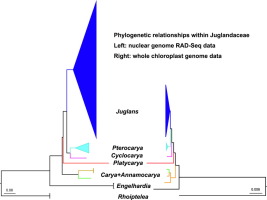当前位置:
X-MOL 学术
›
Mol. Phylogenet. Evol.
›
论文详情
Our official English website, www.x-mol.net, welcomes your feedback! (Note: you will need to create a separate account there.)
Phylogeny and divergence time estimation of the walnut family (Juglandaceae) based on nuclear RAD-Seq and chloroplast genome data.
Molecular Phylogenetics and Evolution ( IF 4.1 ) Pub Date : 2020-03-23 , DOI: 10.1016/j.ympev.2020.106802 Xian-Yun Mu 1 , Ling Tong 2 , Miao Sun 3 , Yi-Xuan Zhu 2 , Jun Wen 4 , Qin-Wen Lin 5 , Bing Liu 6
Molecular Phylogenetics and Evolution ( IF 4.1 ) Pub Date : 2020-03-23 , DOI: 10.1016/j.ympev.2020.106802 Xian-Yun Mu 1 , Ling Tong 2 , Miao Sun 3 , Yi-Xuan Zhu 2 , Jun Wen 4 , Qin-Wen Lin 5 , Bing Liu 6
Affiliation

|
The walnut family Juglandaceae was widely distributed in the Northern Hemisphere while several extant genera now exhibit intercontinental disjunctions. Recent progress in the systematics of Juglandaceae has greatly broadened our knowledge about its origin and evolution. However, there are still uncertainties about the intergeneric relationships within Juglandaceae, and discrepancies between fossil records and inferred divergence times for certain lineages were observed. In this study, well-resolved phylogenies of the Juglandaceae are reconstructed based on both the nuclear RAD-Seq and the whole chloroplast genome data. Our results support the Juglandoideae topology of (Hicoreae, (Platycaryeae, Juglandeae)) at the tribal level. Within Juglandeae, a discordant position of Pterocarya was detected between nuclear and plastid genome data, and a more likely topology (nuclear), (Juglans, (Pterocarya, Cyclocarya)), was discussed based on evidence from molecular data and fossil records. Based on carefully selected fossil calibrations, the divergence times of extant lineages were estimated and they corroborated well with fossil records (especially concerning Juglans and Pterocarya). Four sections within Juglans were strongly supported by the nuclear data. Within Juglans, the incongruent position of J. hopeiensis was recovered between the nuclear and plastid genomes. Yet the origin and evolutionary history of J. cinerea and J. hopeiensis are supported to be complicated and need further clarification. Integrative evidence from the fossil records, phylogeny and lineage divergence times shows that Juglandoideae originated in North America, and migrated to Eurasia via both the Bering and the North Atlantic land bridges. Our study shows the potential of integrative biogeographic studies for illuminating the evolutionary history of Juglandaceae.
中文翻译:

基于核RAD-Seq和叶绿体基因组数据的核桃科(胡桃科)的系统发育和发散时间估计。
核桃科胡桃科广泛分布于北半球,而现存的几个属现在都表现出洲际分离。胡桃科系统学的最新进展极大地拓宽了我们对其起源和进化的认识。然而,胡桃科之间的属间关系仍然存在不确定性,并且观察到化石记录与某些谱系的推断发散时间之间的差异。在这项研究中,基于核RAD-Seq和整个叶绿体基因组数据重建了胡桃科的良好系统发育。我们的结果支持部落级别的(Hicoreae,(Plateycaryeae,Juglandeae))的Juglandoideae拓扑。在Juglandeae中,在核和质体基因组数据之间发现了翼龙的不一致位置,基于分子数据和化石记录的证据,讨论了更可能的拓扑结构(核)(胡格兰(Pugaryarya,Cyclocarya))。根据精心选择的化石标定,估算了现存谱系的发散时间,它们与化石记录(特别是有关胡兰斯和翼龙)的确证了。核数据强烈支持了胡桃岛内部的四个部分。在Juglans内,希望的J.不一致的位置在核和质体基因组之间恢复。然而,灰葡萄和霍普酵母的起源和进化史被认为是复杂的,需要进一步阐明。来自化石记录,系统发育和谱系发散时间的综合证据表明,胡桃科起源于北美,并通过白令河和北大西洋的陆桥迁移到了欧亚大陆。我们的研究显示了整合生物地理学研究在阐明胡桃科进化史方面的潜力。
更新日期:2020-03-26
中文翻译:

基于核RAD-Seq和叶绿体基因组数据的核桃科(胡桃科)的系统发育和发散时间估计。
核桃科胡桃科广泛分布于北半球,而现存的几个属现在都表现出洲际分离。胡桃科系统学的最新进展极大地拓宽了我们对其起源和进化的认识。然而,胡桃科之间的属间关系仍然存在不确定性,并且观察到化石记录与某些谱系的推断发散时间之间的差异。在这项研究中,基于核RAD-Seq和整个叶绿体基因组数据重建了胡桃科的良好系统发育。我们的结果支持部落级别的(Hicoreae,(Plateycaryeae,Juglandeae))的Juglandoideae拓扑。在Juglandeae中,在核和质体基因组数据之间发现了翼龙的不一致位置,基于分子数据和化石记录的证据,讨论了更可能的拓扑结构(核)(胡格兰(Pugaryarya,Cyclocarya))。根据精心选择的化石标定,估算了现存谱系的发散时间,它们与化石记录(特别是有关胡兰斯和翼龙)的确证了。核数据强烈支持了胡桃岛内部的四个部分。在Juglans内,希望的J.不一致的位置在核和质体基因组之间恢复。然而,灰葡萄和霍普酵母的起源和进化史被认为是复杂的,需要进一步阐明。来自化石记录,系统发育和谱系发散时间的综合证据表明,胡桃科起源于北美,并通过白令河和北大西洋的陆桥迁移到了欧亚大陆。我们的研究显示了整合生物地理学研究在阐明胡桃科进化史方面的潜力。



























 京公网安备 11010802027423号
京公网安备 11010802027423号